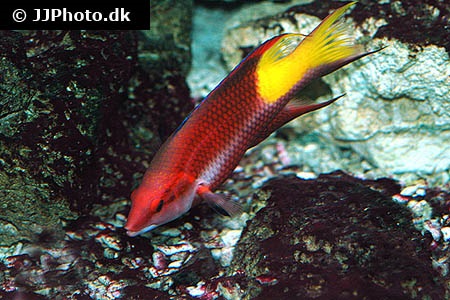Bodianus pulchellus

| Latin name | Bodianus pulchellus - (Poey, 1860) |
|---|---|
| Local name | Spotfin hogfish |
| Family | Labridae - Bodianus |
| Origin | West Indian Ocean, The Mexican Golf |
| Max length | 28 cm (11") |
| Minimum volume |
700 l (185 gal) |
|---|---|
| Hardiness |
Hardy |
| Suitable for aquarium |
Suitable with care |
| Reef safe |
Reef safe with caution |
| Aggressiveness | Might be aggressive towards other species |
| Recommended |
Larger crustaceans (Shrimp, crabs...) Other invertebrates Small crustaceans (Krill, mysis, artemia...) |
|---|---|
| Maybee |
Parasites |
This species likes to eat worms, small bivalves and small crustaceans.
This species searches through the sand for food, which can make the water cloudy and shakes up detritus.
In an aquarium their natural food source in the sand is quickly exhausted.
This species needs a very large aquarium when fully grown.
Exactly how big the aquarium should be is hard to say, but the size of this species is such, that it cannot normally be kept in a home aquarium.
In the aquarium the colour of this species can become matte.
Food with plenty of pigment and generally a varied diet of high quality can help alleviate colour loss.
This species needs good hiding places, for example, between live rocks.
This species revels in swimming and requires an aquarium with ample space.
This species can be aggressive if they are not provided with adequate space.
Several specimen of this species can coexist in the same aquarium, provided they are introduced simultaneously.
This species can change gender from female to male.
When a male is needed, a female changes sex and takes on the role.
This species can be very shy when first introduced into a new aquarium.
More aggressive fish can be introduced after this species has acclimatized.
Hogfish (Bodianus) get their name from the way they look for food in the substrate using their snout. They can regularly be seen blowing water down into the sand and in their natural habitat they often follow other fish which have disturbed it.
Hogfish are quite hardy and in time eat all the most common available fish foods. They do however, demand plenty of space to swim and for concealment.
They can hide for long periods of time if kept with more aggressive species. Hogfish can also be aggressive towards more docile species or those that resembles themselves.
When fully grown they can become a threat to various invertebrates, e.g. worms, snails, small bivalves and crustaceans amongst others.
Wrasses are nearly always seen in reef aquaria, since many of the species are both attractive and useful in battling a range of unwanted invertebrates like i.e. flatworms, pyramide snails.
These fish live of everything from zooplankton to large crustaceans, sea urchins and the like.
The needs and behaviour of Wrasses vary greatly, so it is vital to familiarize oneself with the specific species before buying one.
| Aquarium trade | Yes |
|---|---|
| Distribution | Western Atlantic: South Carolina, USA and Bermuda to Honduras and Santa Catarina, Brazil (Ref. 57756). Eastern Atlantic: São Tomé Island (Ref. 34088). |
| English common names |
Spotfin hogfish |
| Danish common names |
Cubansk svinefisk |
Bob Fenner. The Wrasses We Call Hogfishes - Wet Web Media - (English)
Scott Michael. 2002. Aquarium Fish: The Hogfishes, Family Labridae - Advanced Aquarist - (English)
Scott W. Michael. 2009. Wrasses and Parrotfishes (Reef Fishes Series Book 5) - TFH Publications / Microcosm Ltd. - (English)


